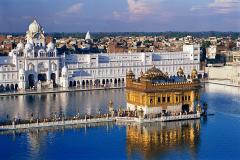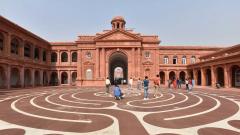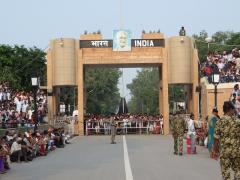Amritsar was founded by Sri Guru Ramdass ji, the fourth guru of the Sikhs in about 1574 A.D. Before the city was founded, the area was covered with thick forests and had several lakes. To start the city the Guru invited 52 traders from different sectors belongings to nearby places like Patti and Kasur to settle here. These families started the first 32 shops in the city which still stand in the street called Batisi Hatta (32 shops). The Guru himself shifted to live among them in the city which came to be called Ramdaspur and has been eulogised in the Guru Granth Sahib.
The construction of Amrit Sarovar from which the city gets its present name was also stared by Sri Guru Ramdass. His successor, Sri Guru Arjan Dev Ji, completed the project and located the Harmandir Sahib in its midst. Later, when Guru Arjan Dev Ji completed the writing of Holy Guru Granth sahib, a copy of Guru Granth Sahib was ceremonially installed in Harmandir Sahib. Baba Buddha Sahib was appointed the First Granthi.
For Booking Call/WhatsApp: 9415218328 / 9415221994
Destinations

The Golden Temple Amritsar India (Sri Harimandir Sahib Amritsar) is not only a central religious place of the Sikhs, but also a symbol of human brotherhood and equality. Everybody, irrespective of cast, creed or race can seek spiritual solace and religious fulfilment without any hindrance. It also represents the distinct identity, glory and heritage of the Sikhs.
This is the holiest temple in the Sikh faith.
Guru Ramdas Sahib, the 4th of 10 Sikh gurus, constructed the temple and its pool in the 1500s as a place of worship for all.
The temple has been renovated many times, adding features such as the marble inlays along the floor. Maharaja Ranjit Singh, founder of the Sikh Empire of India (1799-1849) had the temple's upper floors covered in 750 kilos of pure gold.

Tourists in Amritsar can learn about this defining moment in history at the Partition Museum, the only institution in the world devoted entirely to Partition. It features a haunting collection of newspaper clippings, antique photographs, and oral histories with people who experienced the violence leading up to the separation of the two countries, and the resettling of refugees after the event. The experience will give you a deeper understanding of the source of rivalry between India and Pakistan.

The Mandir Mata Lal Devi is as bizarre as the Golden Temple is elegant. Legend has it that this Hindu temple, dedicated to the female saint Lal Devi, can boost the fertility of women who visit. But to non-devotees, the labyrinthine attraction resembles a funhouse.

Tucked behind the Golden Temple, tourists will find another important site in Amritsar: Jallianwala Bagh. The public garden memorializes the estimated 1,500 people who were killed or injured when British soldiers were ordered to fire on peaceful protesters who were demanding the release of imprisoned leaders of the Indian Independence Movement in 1919. You can still see bullet holes in the walls that hundreds of victims hid behind in attempt to dodge the gunfire.

31-kilometer drive west from the city center of Amritsar will take you to the border of Pakistan, where a curious border-closing ceremony takes place at sunset every afternoon. Full of pomp and circumstance, the Beating Retreat Ceremony involves an ostentatious display of goose-stepping guards from the Indian Border Security Force and the Pakistan Rangers saluting each other, lowering and folding their flags, and closing the gates at the border. Dinner & Overnight at Amritsar hotel.

